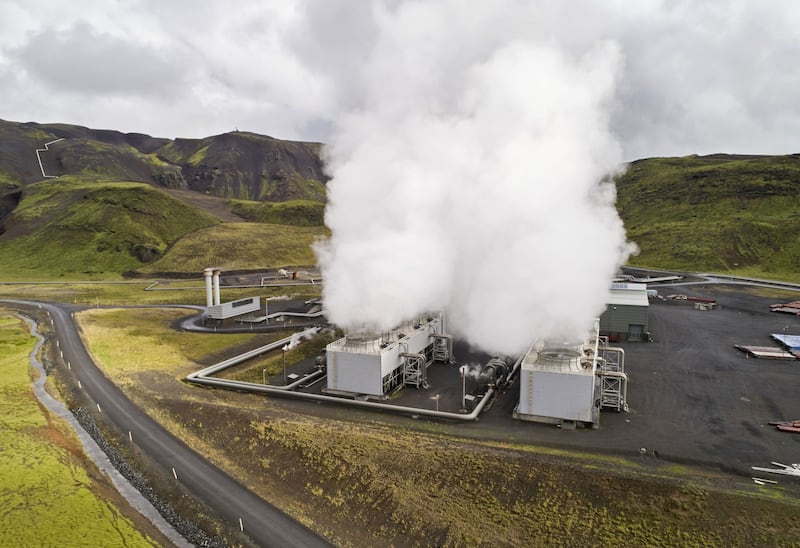Iceland’s famous Blue Lagoon, where tourists boil lobster-red in the volcanic waters, is more than a sightseeing curiosity. The attraction, which is the world’s first geothermal power and district heating plant, is a pioneer of low-carbon energy.
And last Wednesday, another ground-breaking system launched nearby – running greenhouse gas emissions in reverse.
At the Hellisheidi geothermal plant, Swiss company Climeworks unveiled Orca, the world’s largest plant capturing carbon dioxide directly from the atmosphere. In attendance were Iceland’s prime minister, Katrin Jakobsdottir, as well as my colleague at Columbia University and global carbon capture expert Dr Julio Friedmann.
Direct air capture is a special case of the broader technology of carbon capture, use and storage (CCUS).
This takes carbon dioxide from burning fossil fuels and other sources in power plants and industries, separates it, and either disposes of it safely in geological formations kilometres below the surface, or turns it into useful products such as chemicals or ceramics.
The site of Orca has two particular advantages. It is powered entirely by renewable energy from the nearby geothermal plant and the trapped carbon dioxide can be injected underground into the local basalt rock that makes up most of Iceland, where it reacts to form solid minerals that lock it away permanently.
CCUS applied to artificial sources is a way of continuing to use fossil fuels without the negative effect of global warming. Direct air capture is somewhat different – it is about removing the legacy of past emissions and mopping up the remaining unavoidable carbon dioxide releases that will dog our path to “net-zero” around midcentury.
Direct air capture is harder than CCUS at discrete sources – the flue gases from a coal power station are 12 per cent to14 per cent carbon dioxide, but air contains only 0.04 per cent. While large-scale CCUS may cost $50-$100 per tonne of carbon dioxide, Climeworks’ system currently costs $600 to $800 per tonne.
However, air capture systems come in small modular forms, that could eventually be mass-produced more cheaply, as solar panels and wind turbines have come to be.
Climeworks hopes to reach $200 to $300 per tonne by 2030 and halve that a decade later.
The International Energy Agency already assumes developed economies will charge polluters $140 per tonne by 2040, potentially making it cheaper to capture atmospheric carbon dioxide than pay the penalty.
For airline passengers, for instance, with no ready low-carbon alternative, a relatively modest surcharge could cover the costs of neutralising their emissions.
Close to 10 billion tonnes of carbon dioxide would be scrubbed from the atmosphere annually by 2050 and 20 billion tonnes by 2100 as the world seeks to limit warming to no more than the 1.5-2 degrees Celsius committed under the Paris Agreement in 2015.
There are at least three major misconceptions about direct air capture. The first is to complain about the small scale of plants such as Orca. Indeed, its trapping of 4,000 tonnes annually is a minuscule fraction of the 34 billion tonnes or so emitted globally last year. But solar power was similarly negligible two decades ago.
Orca is intended to be a pathfinder, to prove the technology and bring down costs by scaling up. US oil firm Occidental plans to work with another company, Carbon Engineering, to capture one million tonnes per year in Texas.
The second rejoinder, usually expressed in newspaper comment sections is, “Instead of techno-fixes, just plant trees!”
Indeed, replenishing damaged forests and creating new ones is a key part of sucking up carbon dioxide and hopefully creating more space for nature at the same time.
But meeting the 2050 requirement for negative emissions with trees alone would require planting an area about twice the size of India – while not interfering with providing food for a larger global population and not encroaching further on wild landscapes.
Carbon storage in trees is also not reliable – this summer’s forest fires in California burnt an estimated 62,000 hectares that had been earmarked to offset emissions.
The third objection is that direct air capture is a tool of the fossil fuel industries, to allow them to continue business as usual, and it is a dangerous distraction from cutting emissions. It might give governments an excuse for inaction.
Indeed most of the hard work of tackling climate change has to be done by cutting emissions – through improved efficiency, renewables, nuclear power, electric vehicles and other less-mature approaches.
To hit the Paris Agreement targets, though, emissions have to fall 7.6 per cent every year to midcentury. Even a once-in-a-century pandemic with its worldwide lockdowns cut carbon dioxide releases by only 6 per cent last year. Of course, we collectively should have started serious action in the late 1980s when we became fully aware of the climate problem, but we did not. And that is not because governments, corporations or individuals since then have been betting on direct air capture, or another magical solution, doing all the heavy lifting.
Direct air capture offers major opportunities for the Gulf, too. It can be powered by inexpensive solar energy or waste heat. Large subsurface reservoirs offer safe traps for the captured carbon dioxide. The mountains running through Oman and the UAE contain rocks that, like the basalt in Iceland, react readily with carbon dioxide. These are superbly displayed at Sharjah’s Buhais Geological Park.
Gulf national oil companies could offer verified completely carbon-offset oil and gas to their customers. That would sustain the region’s hydrocarbon business, and give it an advantage over competitors.
Direct air capture will not be one of the prime tools tackling climate change in 2030, but it should be solidly established by 2040 and crucial by 2050. Orca is a small but exciting early step. Now is the time for climate businesses to build on it.
Robin Mills is chief executive of Qamar Energy and author of The Myth of the Oil Crisis






